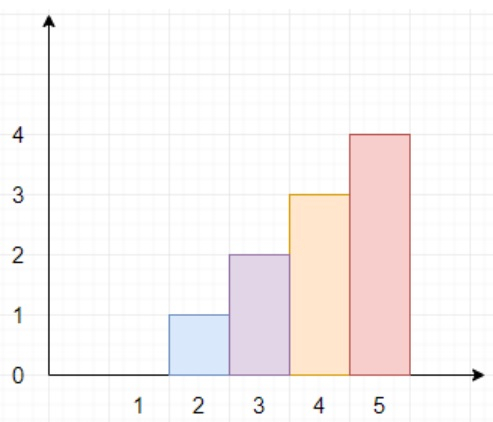在Python中查找最大建筑高度的程序
假设我们有一个值n和另一个名为restrictions的配对列表。我们想在城市中建造n座新建筑物。但有一些限制。我们可以沿着一条线建造建筑物,建筑物从1到n编号。这些限制有两个参数,因此restrictions [i] =(id_i,max_height_i)表示id_i的高度必须小于或等于max_height_i。新建筑物的城市高度限制如下:
- 每栋建筑物的高度必须为0或正值。
-
第一座建筑物的高度必须为0。
-
任何相邻建筑物之间的高度差不能超过1。
我们必须找到最高建筑物的最大可能高度。
因此,如果输入如n = 5,restrictions = [[2,1],[4,3]],则输出将是4,因为我们必须找到最大可能高度,因此可以为4,如图所示。

要解决这个问题,我们将按照以下步骤进行 –
- 如果restrictions为空,则
- 返回n-1
- resi:=基于ID对列表restrictions进行排序
-
k:= 0
-
idx:= 1
-
对于resi中的每个re,请执行以下操作 –
- re [1]:=将re [1]和(k+ re [0] -idx)的最小值
-
k:=re [1]
-
idx:=re [0]
-
k:= resi中最后一个元素的最大高度
-
idx:= resi中最后一个元素的ID
-
反转列表resi
-
从第一个项目开始对resi中的每个re进行以下操作 –
- re [1]:=将re [1]和(k-re [0] + idx)的最小值
-
k:=re [1]
-
idx:=re [0]
-
反转列表resi
-
f:=0
-
idx:= 1
-
res:= 0
-
对于resi中的每个re,请执行以下操作 –
- ff:=(f + re [0] – idx)和re [1]的最小值
-
res:=(re [0] – idx + f + ff)// 2的商和res的最大值
-
idx:=re [0]
-
f:=ff
-
返回(f + n-idx)和res的最大值
示例
让我们看一下以下实现以获得更好的理解
def solve(n, restrictions):
if not restrictions:
return n-1
resi = sorted(restrictions, key = lambda x:x[0])
k = 0
idx = 1
for re in resi:
re[1] = min(re[1], k+re[0]-idx)
k = re[1]
idx = re[0]
k = resi[-1][1]
idx = resi[-1][0]
resi.reverse()
for re in resi[1:]:
re[1] = min(re[1], k-re[0]+idx)
k = re[1]
idx = re[0]
resi.reverse()
f = 0
idx = 1
res = 0
for re in resi:
ff = min(f+re[0]-idx, re[1])
res = max(res, (re[0] - idx + f + ff) // 2)
idx = re[0]
f = ff
return max(f+n-idx,res)
n = 5
restrictions = [[2,1],[4,3]]
print(solve(n, restrictions))
输入
5, [[2,1],[4,3]]
输出
4
 极客教程
极客教程